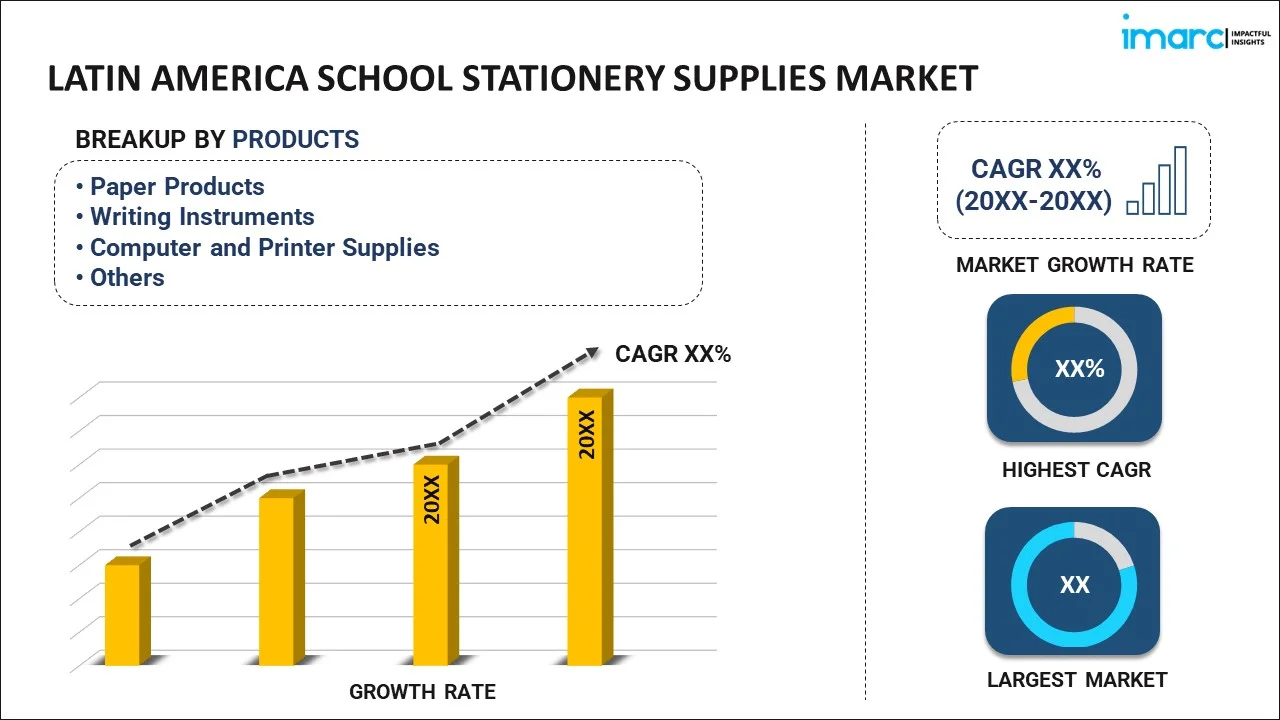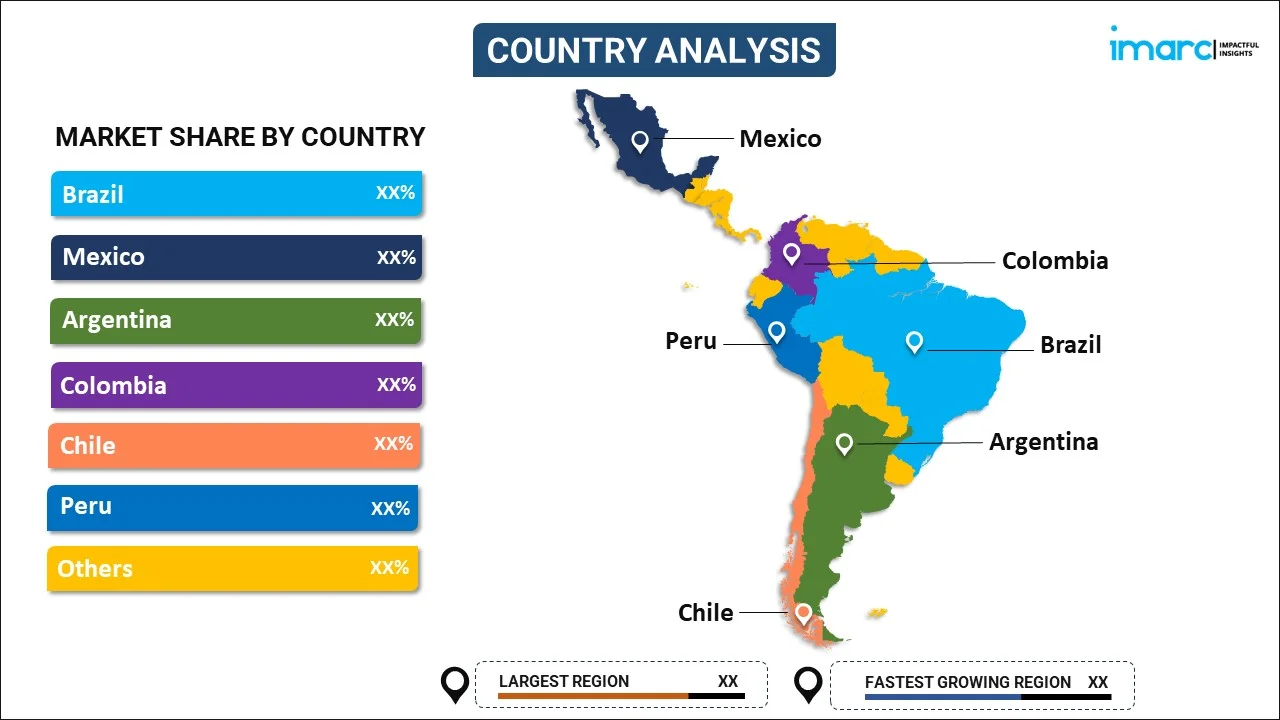
Latin America School Stationery Supplies Market Report by Product (Paper Products, Writing Instruments, Computer and Printer Supplies, and Others), Distribution Channel (Stationary and Book Shops, Supermarkets and Hypermarkets, Online, and Others), End-User (K-12, Higher Education), and Country 2025-2033
Market Overview:
The Latin America school stationery supplies market size reached USD 6.6 Billion in 2024. Looking forward, IMARC Group expects the market to reach USD 8.8 Billion by 2033, exhibiting a growth rate (CAGR) of 3.2% during 2025-2033.
|
Report Attribute
|
Key Statistics
|
|---|---|
|
Base Year
|
2024 |
|
Forecast Years
|
2025-2033
|
|
Historical Years
|
2019-2024
|
| Market Size in 2024 | USD 6.6 Billion |
| Market Forecast in 2033 | USD 8.8 Billion |
| Market Growth Rate (2025-2033) | 3.2% |
School stationery supplies assist students in performing basic tasks like writing, drawing, and crafting. They generally include pencils, pens, erasers, sharpeners, crayons, highlighters, notebooks, pencil boxes and sketch pens. They are widely available in different materials, such as metal, plastic, graphite, paper, and wood. Besides this, cardboard, marble and other materials are also used in the manufacturing of school stationery supplies across Latin America.
Brazil is home to the most prominent schools in Latin America, which contributes to the rising utilization of stationery supplies. In addition to this, the increasing brand awareness among individuals, growing investment in creative marketing techniques by key manufacturers, increasing literacy rate and emerging higher education systems act as another growth-inducing factor in the region. Furthermore, the leading players are increasingly focusing on the development of unique and innovative products to gain a competitive edge in the market. As a result, they are introducing sustainable and eco-friendly oil paints, crayons, sketch pens, watercolors, and paintbrushes. However, the ongoing coronavirus disease (COVID-19) and lockdown restrictions imposed by governing agencies of several countries in the region has obstructed the supply chain and operations of the manufacturing units. This has adversely impacted the overall market. The market will witness an increase in overall sales once the pandemic becomes under control and lockdown restrictions are uplifted.
Key Market Segmentation:
IMARC Group provides an analysis of the key trends in each segment of the Latin America school stationery supplies market report, along with forecasts at the regional and country levels from 2025-2033. Our report has categorized the market based on product, distribution channel, and end-user.
Breakup by Product:

- Paper Products
- Writing Instruments
- Computer and Printer Supplies
- Others
Breakup by End-User:
- K-12
- Higher Education
Breakup by Distribution Channel:
- Stationary and Book Shops
- Supermarkets and Hypermarkets
- Online
- Others
Breakup by Country:

- Brazil
- Mexico
- Argentina
- Colombia
- Chile
- Peru
- Others
Competitive Landscape:
The competitive landscape of the industry has also been examined along with the profiles of the key players.
Report Coverage:
| Report Features | Details |
|---|---|
| Base Year of the Analysis | 2024 |
| Historical Period | 2019-2024 |
| Forecast Period | 2025-2033 |
| Units | Billion USD |
| Segment Coverage | Product, Distribution Channel, End User, Country |
| Countries Covered | Brazil, Mexico, Argentina, Colombia, Chile, Peru, Others |
| Customization Scope | 10% Free Customization |
| Post-Sale Analyst Support | 10-12 Weeks |
| Delivery Format | PDF and Excel through Email (We can also provide the editable version of the report in PPT/Word format on special request) |
Key Questions Answered in This Report:
- How has the Latin America school stationery supplies market performed so far and how will it perform in the coming years?
- What has been the impact of COVID-19 on the Latin America school stationery supplies market?
- What are the key regional markets?
- What is the breakup of the market based on the product?
- What is the breakup of the market based on the end user?
- What is the breakup of the market based on the distribution channel?
- What are the various stages in the value chain of the industry?
- What are the key driving factors and challenges in the industry?
- What is the structure of the Latin America school stationery supplies market and who are the key players?
- What is the degree of competition in the industry?
Need more help?
- Speak to our experienced analysts for insights on the current market scenarios.
- Include additional segments and countries to customize the report as per your requirement.
- Gain an unparalleled competitive advantage in your domain by understanding how to utilize the report and positively impacting your operations and revenue.
- For further assistance, please connect with our analysts.
 Request Customization
Request Customization
 Speak to an Analyst
Speak to an Analyst
 Request Brochure
Request Brochure
 Inquire Before Buying
Inquire Before Buying




.webp)




.webp)












